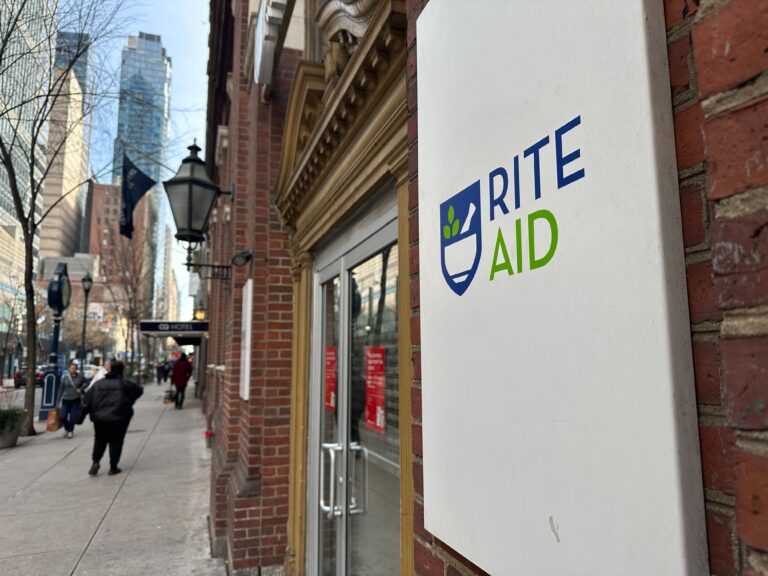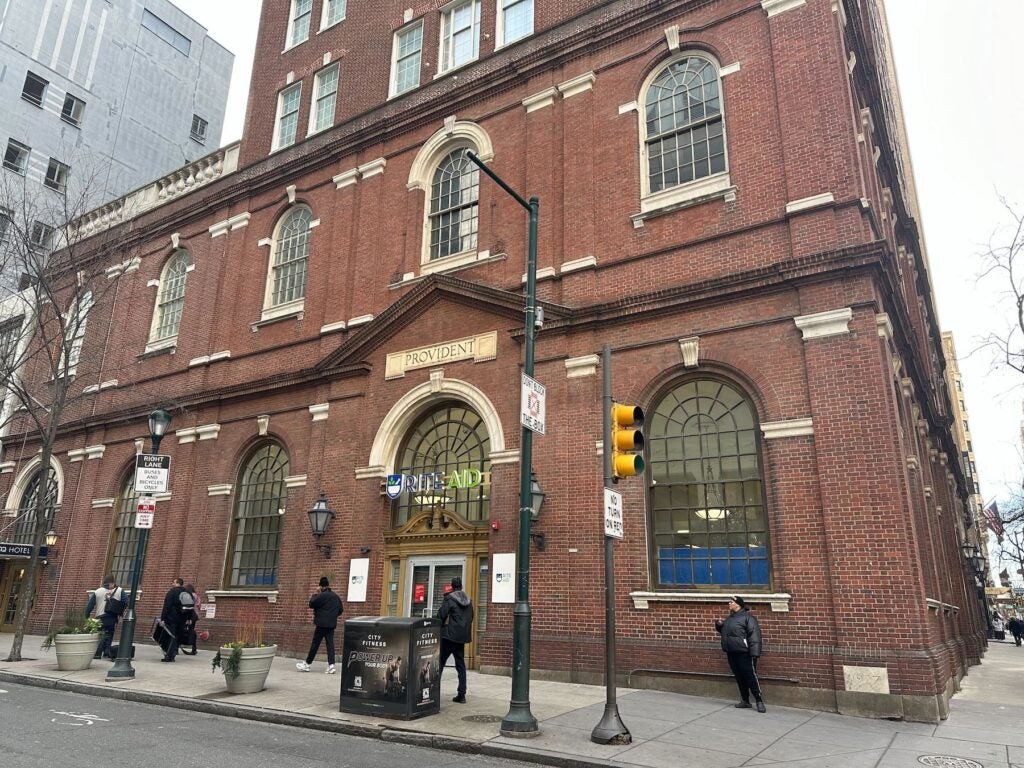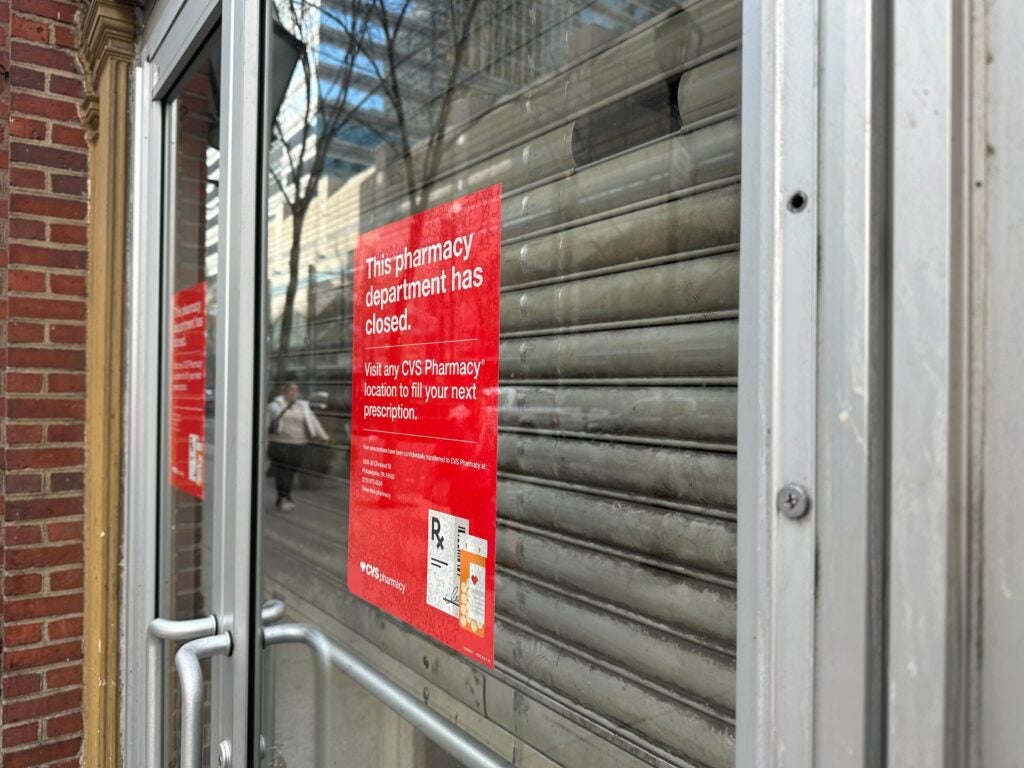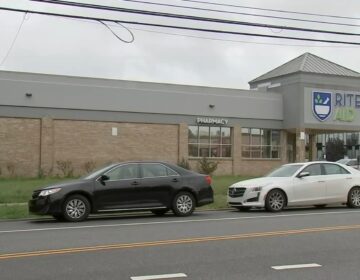How many ‘zombie’ stores will be left in the Philly area after Rite Aid’s bankruptcy?
There will be more vacant stores as the bankruptcy process enables companies like Rite Aid to break their leases. Here’s what’s happening behind the scenes.
Listen 1:37
Philadelphia-based RiteAid Pharmacy is closing dozens of stores in the tri-state area and hundreds more nationwide as it downsizes retail amid bankruptcy. (Kristen Mosbrucker-Garza /WHYY)
From Philly and the Pa. suburbs to South Jersey and Delaware, what would you like WHYY News to cover? Let us know!
Anyone hoping to catch a glimpse of Philadelphia’s architectural history by lingering in the aisles of a Center City Rite Aid, lost their chance — for now.
Instead, window shoppers banking to mull medications or grocery staples on their lunch break will only see plain corrugated steel behind locked glass doors.
Hidden from view are the ornate moldings on high ceilings and a chandelier dating back to the early 1900s near Rittenhouse Square.
That’s because the Philadelphia-based retailer Rite Aid filed for Chapter 11 bankruptcy protection in October 2023. It’s now on track to shutter hundreds of stores nationwide.
The former Rite Aid at 17th and Chestnut Street closed this month. The lease for that space is on the auction block slated for Feb. 8, as are dozens of other stores across the Delaware Valley.
But court records show the Rite Aid retail auction has already been pushed back several times.

Rite Aid did not respond to WHYY News’ requests for an interview for this story.
For now, it’s unclear how much of an economic development logjam the slew of recent Rite Aid store closures may be – some sites could take months. Others may linger for years like zombies — shuttered but with no movement, affecting customers and other businesses and developers hoping for a vibrant commercial corridor.
“They paid the most rent. And they also brought very good credit to a landlord,” said Steve Gartner, executive vice president for CBRE, a global commercial real estate advisory company. “What landlord would not want a pharmacy as their tenant?”
For perspective, the average 13,000-square-foot retail pharmacy store might have paid $40 per square foot and was locked into a 10-year lease. But now, all those leases are broken under the bankruptcy court process, which means more unexpected vacancies. In Center City, there’s already plenty of vacant retail competition for businesses to take a risk on.
“Many of those landlords bought those [Rite Aid] properties as a passive investment. And that landlord might be the owner of just that one piece of real estate,” Gartner said. “They don’t care about the street. Let alone the neighborhood.”
The delta between a commercial building staying open or closed is much more complicated than whether the ground floor retail operator has locked the doors.
It also matters to more than just casual shoppers or architectural shutterbugs, tax bills for commercial building owners are easily tens of thousands of dollars each year, which all help fund all city services.
While real estate professionals assure that many former Rite Aid stores are already in prime locations for redevelopment opportunities — such as on a commercial corridor in one of the wealthiest communities in the city — less robust corridors like Market East are still struggling from the retailer pulling out of the market years ago.
Since its closure in May 2022, the former Rite Aid at the corner of 10th and Market Street has been mostly a vacant storefront across from the redeveloped Fashion District in Center City. In October 2023, it was temporarily a Spirit Halloween shop but it is now dark again. The lease for that retail site is expiring in July 2024, according to its lease advertisement on Loopnet.
WHYY News was unable to contact both former Rite Aid landlords for a news interview, but deeds show a narrative history of ownership.
Deeds show that there are several owners on that property in a deal that’s been transferred through inheritances as generational wealth is passed down. The deal is structured where passive income from rent is collected and shared among a group using trusts. But that’s not the only common deal structure, especially for stand-alone suburban properties. In smaller towns – many of which are also losing Rite Aid chain stores – the hit to local tax rolls could be bigger.
“There’s a lot of single ownership [buildings among Rite Aid landlords],” said Lance Marine, managing principal at Winmar Advisory, a real estate brokerage that has handled divesting Rite Aid’s retail portfolio. “It might have been their only asset. A lot of them were inherited. They’re not active investors.”
In general, there’s been pressure for national retailers to pay sky-high rents in urban markets for decades but there’s also dozens of single purpose properties in more suburban communities where local municipalities rely on property taxes more than a city like Philadelphia.
“It’s presenting a genuine struggle for landlords that have to replace rents that might be $40 a foot,” said CBRE’s Gartner. “The replacement tenant might be less than half [that] because that’s where the demand is. There are replacement tenants, some might be small grocery stores, national chains or they might be locals – but they won’t be pharmacies.”
It’s not all doom and gloom either – but it’s going to take initiative from a property owner that’s been largely absent.
“It’s now requiring a landlord that was very passive to have to do something, maybe spend money, maybe divide the space into two or three smaller spaces because that’s more desirable,” Gartner said. “Sometimes we just don’t know until we take it to market, they’re not inherently bad real estate.”
In the meantime, what happens with the tax bills? In short, taxes must be paid like any other property, but the likelihood of appeals is high — such as what’s happening at the Market East Rite Aid.
The property owner at 10th and Market Street still owes $35,000 to the city in property taxes alone last year. But the owner is appealing that determination by arguing the building isn’t worth that much anymore because it’s empty with no ground-floor retail tenant which is a common tactic.
As dozens of communities look to replace shuttered Rite Aid pharmacies this year after its bankruptcy the upcoming auction for Rite Aid leases opens the door to a wider variety of stores – even local boutiques or event spaces.

“A hundred percent. I think that when you eliminate barriers to entry,” said Marine, the national broker. “A deal that doesn’t make sense to sublease for Rite Aid, might make sense to a property owner who has a vacant no tenancy and has a long-term vision.”
There’s still demand for retail storefronts, especially discount stores, but also experiential businesses like car washes or medical offices.
“At one point pharmacies were wildly and aggressively expanding and you saw them on every corner,” Marine said. “Retail is constantly evolving.”
When any national retailer starts divesting dozens of brick-and-mortar stores that are ubiquitous in any community — the difference between a good and bad redevelopment might come down to whether the building owner is local – or not.
In a city like Philadelphia, MPN Realty principal Veronica Blum said there are many building owners who care, and that’s the best-case scenario.
“The more we can have people who are local owners it really does help,” she said. “We explain the economics to landlords so they can underwrite the assets and satisfy their lenders. It doesn’t help anyone to have banks, to have lenders own these assets, it doesn’t help because that’s really hands off.”
While Philadelphia doesn’t collect most of its revenue from property taxes — but rather generates most of its money from city wage taxes — there will likely be a wave of appeals because there’s more vacancy.
Commercial properties have hefty tax bills of tens of thousands of dollars for each site — but if the city’s tax board agrees that an abandoned building isn’t as valuable as one with a tenant inside — the owner could get a break.
State and local tax attorney Jennifer Karpchuk with Chamberlain Hrdlicka explained that it’s all about proof.
“The only way they’re going to get the relief is if there is a substantiation for the reduction of the value, right? So they have to prove that the property — is not worth whatever the city believes the property is worth on the books,” she said.
In general, there’s been some appetite by the city’s tax office to consider reductions in the property’s valuation and grant relief.
“In this market right now, there have been reductions in a range of commercial properties, but there’s no hard and fast rule,” said Peter Kelsen, partner at law firm Blank Rome, who specializes in real estate taxes. “The [city’s] revenue stream drops because the assessment is reduced, but there are other properties that are being just developed or are doing very well and their taxes are raised because their values are going up. So it’s a little bit of a balance.”
But what if there was a tax abatement on a building that’s now vacant?
“When they’re active even though there’s a real estate tax abatement that covers the real estate side tax property of the ledger but the property also generates occupancy taxes – those don’t get abated,” he said. “Now when it closes or is vacant the abatement is still in place for the real estate taxes as it would have been if it was active but now they don’t pay an occupancy tax because you only pay that when there’s active space.”
A dark store doesn’t always mean the building owner is struggling, either.
“Sometimes you have a dark store but it’s still generating rent. They closed it because it’s cheaper to close it than operate it but they’re still paying rent to the landlord,” he said. “
For the Rittenhouse Square area Rite Aid, a retrofit for the historic Provident Bank and Trust Company’s ground floor retail at the bottom of a hotel, the path forward could be swifter than in Market East.
Once the deal’s specifics are hammered out there’s also a question about what infrastructure needs work – like electrical, foundation or facades.
“You’re really looking at who can fit inside a 13,000 square foot box and use that space,” said Blum, the commercial real estate broker. “That specific building has historic nature to the outside and it limits the visibility of the retail presence on the street. But because there’s already a hotel there’s use upstairs so you’re not going to tear the building down like let’s say you maybe do at 23rd and Walnut [Street] to redevelop that site. Hopefully they are taking advantage of the wonderful ceiling height.”

Get daily updates from WHYY News!
WHYY is your source for fact-based, in-depth journalism and information. As a nonprofit organization, we rely on financial support from readers like you. Please give today.





